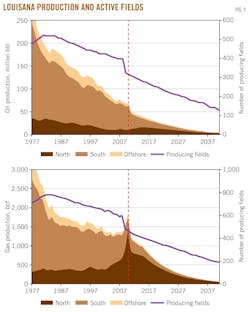P. 3 ~ Continued - How Haynesville shale will lift Louisiana's gas production profile
The majority of field discoveries were made before 1977 and most active fields as well as the majority of oil production are from pre-1977 discoveries. Over 80% of Louisiana's oil production is derived from fields discovered prior to 1977, while 60% of gas production derives from fields discovered over the past 5 years.
Producing fields exhibit a variety of complex behavior reflecting geologic conditions and investment and management intervention. The preferred unit for performance analysis is individual wells, but in Louisiana, production is often only available for a multiwell lease or a production unit.
Production may show a continual decline after peak production, but more often, trends exhibit short-term spikes, long periods of inactivity, multiple production peaks, and related characteristics that are not well-suited to traditional decline curve analysis. Varying levels of growth activity occur over time, related to recompletions, offset drilling, and similar activity.
A combination of heuristic and analytic techniques previously applied to structures in federal waters6 was modified and adapted for Louisiana's producing fields. A discussion of the flowcharts and details of the methods and procedures can be found in Kaiser.7 The main result of the algorithms is shown in Fig. 5.
Undiscovered conventional fields module
Field discoveries
The number of fields remaining to be discovered and developed in a geographic region is unknown and uncertain.
Large fields are generally found early in exploration, and field sizes and the number of discoveries tend to decrease over time unless a new exploration concept develops or new areas are opened to exploration. Statistical models are region-specific to account for each areas unique geologic history, prospectivity, and cost structure.
The number of new field discoveries in Louisiana has been relatively stable over the past 2 decades with fewer than 15 new fields/year identified. The average number of fields discovered by region and primary product are shown in Table 1 over a 5, 10, and 20-year horizon. In recent years the number of field discoveries has been relatively small, less than two or three discoveries per year per region.
Discovery model
We adopt historic discovery rates to estimate the number, location, and size of future conventional field discoveries.
We assume that over the next 5 years the average number of fields discovered will be similar to the number of conventional fields discovered in the past 5 years and the size and production profiles of these new fields will be analogous to previous discoveries in each region.
Engineers and geologists rely upon the use of analogies to estimate reservoir parameters and performance expectations during the early development stages of a field when no production and geologic data are available. Areal proximity is one of the most important features when establishing proof of analogy: "If performance trends have not been established with respect to oil and gas production, future production rates and reserves may be established by analogy to reservoirs in the same geologic area having similar characteristics and established performance trends."8
In North Louisiana, two gas fields and one oil field are assumed to be discovered and brought on line each year, and in the South, two gas fields, one oil field, and two offshore gas fields will come into production each year over the next 5-year period.
Displaying 3/6
View Article as Single page





